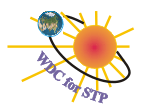|
|
|
Ionospheric Phenomena (description)
Introduction
The ionosphere is that part of the upper atmosphere where free electrons occur in sufficient density to have an appreciable
influence on the propagation of radio frequency electromagnetic waves. This ionization depends primarily on the Sun and its
activity. Ionospheric structures and peak densities in the ionosphere vary greatly with time (sunspot cycle, seasonally,
and diurnally), with geographical location (polar regions, auroral zones, mid latitudes, and equatorial regions),
and with certain solar-related ionospheric disturbances. The major part of the ionization is produced by solar X-ray
and ultraviolet radiation and by corpuscular radiation from the Sun. The most noticeable effect is seen as the Earth
rotates with respect to the Sun; ionization increases in the sunlit hemisphere and decreases on the shadowed side.
Although the Sun is the largest contributor toward the ionization, cosmic rays also make a small contribution.
Any atmospheric disturbance affects the distribution of the ionization. The ionosphere is a dynamic system controlled
by many parameters including acoustic motions of the atmosphere, electromagnetic emissions, and variations in the
geomagnetic field. Because of its extreme sensitivity to atmospheric changes, the ionosphere can be used as a sensitive
monitor of atmospheric events.
Definitions of the Ionospheric Regions
The ionosphere is divided into four broad regions called D, E, F, and topside. These regions may be further divided into
several regularly occurring layers, such as F1 or F2. D Region: The region between about 75 and 95km above the Earth
in which the (relatively weak) ionization is mainly responsible for absorption of high-frequency radio waves.
E Region: The region between about 95 and 150km above the Earth that marks the height of the regular daytime E layer.
Other subdivisions isolating separate layers of irregular occurrence within this region are also labeled with
an E prefix, such as the thick layer, E2, and a highly variable thin layer, Sporadic E. Ions in this region are mainly O2+.
F Region: The region above about 150km in which the important reflecting layer, F2, is found. Other layers within this
region are also described using the prefix F, such as a temperate-latitude regular stratification, F1, and a low-latitude,
semi-regular stratification, F1.5. Ions in the lower part of the F layer are mainly NO+ and are predominantly O+ in the upper
part. The F layer is the region of primary interest for radio communications. Topside: This part of the ionosphere starts
at the height of the maximum density of the F2 layer of the ionosphere and extends upward with decreasing density to a
transition height where O+ ions become less numerous than H+ and He+ ions. The transition height varies but seldom drops
below 500km at night or 800km in the daytime, although it may lie above 1000km. Above the transition height, the weak
ionization has little influence on transionospheric radio signals.
History of Vertical Incidence Soundings
Sounding of the ionosphere began in 1925. By 1947, an instrument known as the ionosonde was routinely used to measure
automatically the characteristics of the ionosphere. During the International Geophysical Year (IGY) of 1957-1958,
an international cooperative effort created a worldwide network of ionosondes to record vertical incidence measurements
for the 1957-1959 period of maximum solar activity. The IGY ionosonde was a relatively simple, robust, inexpensive
piece of equipment by today's standards. Several countries built IGY ionosondes with few differences among them and
thus provided similar worldwide photographic records called ionograms. Since the IGY, a loosely coordinated worldwide
network of vertical incidence ionosondes, varying between 100 and 200 sites, has operated continuously.
Ionograms
Ionograms are recorded tracings of reflected high frequency radio pulses generated by an ionosonde. Unique relationships
exist between the sounding frequency and the ionization densities which can reflect it. As the sounder sweeps from lower
to higher frequencies, the signal rises above the noise of commercial radio sources and records the return signal
reflected from the different layers of the ionosphere. These echoes form characteristic patterns or "traces" that
comprise the ionogram. Radio pulses travel more slowly within the ionosphere than in free space, therefore, the apparent
or "virtual" height is recorded instead of a true height. For frequencies approaching the level of maximum plasma frequency
in a layer, the virtual height tends to infinity, because the pulse must travel a finite distance at effectively zero speed.
The frequencies at which this occurs are called critical frequencies. Characteristic values of virtual heights
(designated h'E, h'F, and h'F2, etc.) and critical frequencies (designated foE, foF1, and foF2, etc.) of each layer a
re scaled, manually or by computer, from these ionograms. Typically, an ionosonde station obtains one ionogram recording
every 15 minutes. When the scaling is done manually, only the hourly recordings are routinely reduced to numerical data
(parameters). Modern ionosondes with computer-driven automatic scaling procedures routinely scale all the ionograms recorded.
|
|
|



